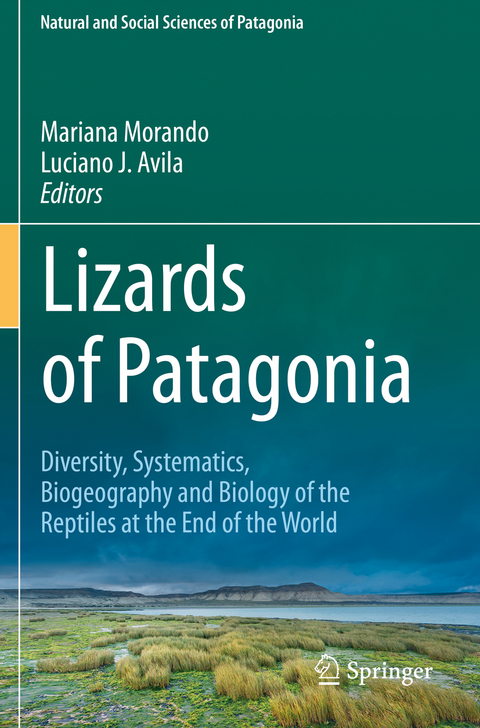
Lizards of Patagonia
Springer International Publishing (Verlag)
978-3-030-42754-2 (ISBN)
lt;b>Dr. Mariana Morando is a Principal Researcher at the National Research Council of Argentina, working at the Instituto Patagónico para el Estudio de los Ecosistemas Continentales of Puerto Madryn, Chubut, and Professor of Evolution and Genetics at the Universidad Nacional de la Patagonia San Juan Bosco. She completed her basic studies at the Universidad Nacional de Río Cuarto in 1994, a Master at Brigham Young University (BYU, USA) in 2003, her PhD at Universidad Nacional de Tucumán in 2004 (Argentina), and a postdoctoral leave at BYU in 2014-2015. Her research focuses on phylogenetic and phylogeographic aspects of the Patagonian and northwestern lizard fauna of Argentina, mainly using molecular markers. She has authored or co-authored 117 peer-reviewed papers.
Dr. Luciano Javier Avila is a Principal Researcher at the National Research Council of Argentina working at the Instituto Patagónico para el Estudio de los Ecosistemas Continentales of Puerto Madryn, Chubut. He completed his undergraduate studies at the Universidad Nacional de Río Cuarto in 1990, his PhD at the Universidad Nacional de Tucuman in 1996 and a postdoctoral stay at Brigham Young University (USA) in 2000-2004. His research focuses on the taxonomy, phylogeny and natural history of the southern South American Herpetofauna. He is the author or co-author of 195 articles and notes on species limits, phylogenies, phylogeographies, bioinventories, biogeography, spatial ecology and natural history (including 90 peer-reviewed articles), nearly 80% of which involved Patagonian lizards.
Section I - Historical and general background -1) History of Discovery of the Patagonian Lizards.- 2) Lizards within the cultural and symbolic context of Patagonia.- Section II - Land, climate and vegetation background - 3) Landscapes and geology, a general introduction to the land of reptiles.- 4) Paleoclimatology of Patagonia since the Cretaceous to the Holocene .- 5) Geographical singularities of the Patagonian climate.- 6) Major phytogeographic units of Patagonia.- 7) The Patagonian fossil lizards.- Section III - Diversity and current knowledge of Patagonian lizards - 8) Naming the diversity: taxonomy of current species of Patagonian lizards.- 9) Phylogenetics, phylogeography and biogeography of Patagonian Steppe lizards.- 10) Phylogeography of lizards in Chile: the role of the history of geographic space on the distribution of its intraspecific diversity.- 11) General ecology of Patagonian lizards.- 12) Reproductivebiology of lizards from cold and harsh environments of Patagonia Argentina.- 13) Effects of global warming on ecophysiology of lizards of Patagonia, Argentina.- 14) Conservation of lizards from Patagonia: current status, trends and management proposals.
"The subtitle of the book refers to the 'Reptiles at the End of the World.' To me, phrases like this, commonly applied to Patagonia, give an almost apocalyptical impression ... . Let's hope that the end of world applies only in its geographical connotation, and that future researchers can use this book as a road map for the benefit of Patagonian lizards and other species in this wonderful and vast region of the world." (Juan D. Daza, Herpetological Review, Vol. 53 (3), 2022)
“The subtitle of the book refers to the ‘Reptiles at the End of the World.’ To me, phrases like this, commonly applied to Patagonia, give an almost apocalyptical impression … . Let’s hope that the end of world applies only in its geographical connotation, and that future researchers can use this book as a road map for the benefit of Patagonian lizards and other species in this wonderful and vast region of the world.” (Juan D. Daza, Herpetological Review, Vol. 53 (3), 2022)
| Erscheinungsdatum | 26.08.2021 |
|---|---|
| Reihe/Serie | Natural and Social Sciences of Patagonia |
| Zusatzinfo | XX, 432 p. 112 illus., 99 illus. in color. |
| Verlagsort | Cham |
| Sprache | englisch |
| Maße | 155 x 235 mm |
| Gewicht | 688 g |
| Themenwelt | Naturwissenschaften ► Biologie ► Evolution |
| Naturwissenschaften ► Biologie ► Zoologie | |
| Schlagworte | Andean Patagonian forest • Cold desert herpetofauna • Gondwanan reptiles • Homonota • Leiosaurae • Liolaemus • Model vertebrates • Neotropical lizards • Patagonian Steppe • Phymaturus • Southern South America |
| ISBN-10 | 3-030-42754-4 / 3030427544 |
| ISBN-13 | 978-3-030-42754-2 / 9783030427542 |
| Zustand | Neuware |
| Haben Sie eine Frage zum Produkt? |
aus dem Bereich


